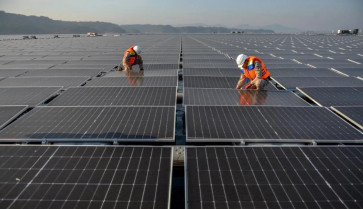Popular Reads
Top Results
Can't find what you're looking for?
View all search resultsPopular Reads
Top Results
Can't find what you're looking for?
View all search resultsEnhancing sustainability policies for Indonesia
Having taxonomy means that the government could proceed to the next step, which is consistent and transparent sustainable financial policies.
Change text size
Gift Premium Articles
to Anyone
T
he United Nations climate conference (COP28) in Dubai last week produced a significant step to help countries achieve net-zero emissions by 2050.
The United Arab Emirates Consensus agreed to transition away from fossil fuels. This was a milestone because, for the first time, all the global leaders put oil and gas in the formal text agreement. Since COP26 in Glasgow, all attention has seemed to focus on how we are phasing out coal and blaming coal-producing countries for global warming. The UAE Consensus is a game changer that brings more responsibility to more advanced countries on the importance of reducing greenhouse gas emissions in energy sectors.
Indonesia pledged to reduce 385 million tonnes of carbon emission in energy sectors at COP28. Part of the strategy is to boost renewable energy supply in the next decade. This year, a significant milestone has been achieved with the launching of a carbon market by the Indonesia Stock Exchange (IDX) and the establishment of the 145-megawatt Cirata Solar Power Plant in West Java, the most extensive solar power plant in Southeast Asia. However, those initiatives are still far from the target set by the government.
Indonesia has set a target of an energy mix in which renewable energy will account for 23 percent of the electricity sector by 2025. In the latest data, in 2023, the share of renewable energy was only 12.5 percent. According to the IESR, we have to be able to increase capacity by about 6-7 gigawatts per year to achieve the target. And for that, we need a lot of support from private-sector investment.
According to the Energy and Mineral Resources Ministry, investment in renewable energy sectors was US$1.17 billion, or only 65 percent of the target of $1.8 billion. Complex problems hinder us from achieving the energy mix target as mandated.
The issues of oversupply and the price of electricity make renewable energy a difficult sell for investors and banks. The government realizes these obstacles and is in the process of revising some regulations.
On the other hand, we notice some notable progress in the electricity sector. There are now 43 steam power plants that successfully utilize biomass for co-firing in producing electricity. This co-firing option is relatively affordable and accessible without large-scale capital investment needs. In parallel, it will help us achieve the target for the renewable energy mix and to reduce carbon emissions by 2030. The new energy ministry regulation requires new steam power plants to utilize and enhance co-firing in producing electricity, with the target of 10.2 million tonnes of biomass consumption in 2025.



















